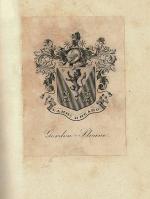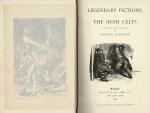Kennedy, Legendary Fictions of The Irish Celts.
Legendary Fictions of The Irish Celts. Collected and Narrated by Patrick Kennedy.
Second Edition. London, MacMillan and Co. and New York, 1891. Octavo (13 cm wide x 19 cm high). Frontispiece, XVI, 312 pages plus 44 pages of Publisher’s catalogue and Index. Original, very decorative Publisher’s cloth with gilt lettering and ornament to spine and front board. Very good condition with only very minor signs of wear. With the Bookplate of Gordon Sloane (Lamh Dhearg) to the endpaper). A very rare and important source of irish, celtic Legends.
This important and rare source for irish legend was compiled by Wexford native Patrick Kennedy. The Volume includes for example:
Part I: Household Stories
This part includes for example: Jack and his Comrades, Adventures of Gilla na Chreck and Gour, “I’ll be wiser next time”, The Corpse Watchers, The Brown Bear of Norway, The Goban Saor, etc.
Part II: Legends of the “Good People”
This part includes for example: The Fairy Child, The Changeling and his Bagpipes, The Tobinstown Sheeoge, The Breton Version of the Palace in the Rath, Faction-Fight among the Fairies, Jemmy Doyle in the FAiry Palace, The Fairy Cure etc.
Part III: Witchcraft, Sorcery, Ghosts and Fetches
Part IV: Ossianic and Other Early Legends
Part V: Legends of the Celtic Saints
Patrick Kennedy (early 1801 – 29 March 1873) was a folklorist from County Wexford, Ireland. An educator turned bookseller, who also contributed various articles and reviews as a writer, he eventually became best known as a collector and publisher of Irish folktales and folklore, particularly from his native County Wexford.
Kennedy was born in the early part of 1801 in Kilmyshal beyond the outskirts of Bunclody, County Wexford, Ireland, in a financially well-off family of peasant stock. The lived in the village of Kilmyshal until he reached age six, and Mount Leinster, which loomed tall over his boyhood hometown, served as a backdrop of his first book.
In 1807, the family moved to a district in Castleboro, Killegney civil parish, County Wexford; it is known they resided particularly at Coolbawn townland from 1810 to 1814. Then in 1814 they moved again three miles east to Courtnacuddy, Rossdroit civil parish. During this period, Patrick went away briefly in 1813 to attend school at Shanowle near Taghmon, staying with his mother’s relatives, but this lasted only one or two terms. Subsequently, he was schooled closer to home at Cloughbawn, in Clonroche townland. The school was run by the famous “Mr. O’Neill”, and at first Patrick’s classes were held at the Cloughbawn Parish Church, until a schoolhouse was erected by the landlord, Robert Carew. Patrick lodged at the home was Morgan Dunne, his room and board paid for by tutoring. The Cloughbawn school had high standards and Patrick would later commend it in writing. His studies there lasted until 1818 or late 1819.
In 1819 when he took up a temporary teaching post at Tombrick School vacated by a friend (O’Brien) who was going to attend the Teachers Training School at Kildare Place. In 1820 or 21, Kennedy himself went to Dublin to enroll in the teacher-training program at Kildare Place (officially called the “Society for Promoting the Education of the Poor of Ireland”), and received such high evaluations that after completing the program c. 1821, he was not assigned to his landlord’s school, as might have been expected, but gained employ at the Society itself as an instructor, or as Junior Assistant to the Superintendent, c. 1822. The Society, which the British Government as the apparatus overseeing the education of the whole of Ireland, was abolished in 1831, due to pressure from proponents of the Catholic Emancipation movement.
After the abolition of his position in 1831, Patrick Kennedy set himself up as a “Drawing Master”, and as of 1836 his name is found registered with the Dublin Directory as Professor of Drawing. He married Maria Kelly on 24 October 1832. The Commission of Education which replaced the Society emphasized agricultural learning, and when the Glasnevin facility with a farm for practical training and a residence for the trainee teachers were completed in 1838, Kennedy was appointed Superintendent. But he was dismissed shortly after, having quarreled with the farm’s manager.
At an uncertain time, he abandoned the teaching profession and established a lending-library and bookseller shop on 8 Anglesea Street, Dublin, which he later moved to the Anglesea Street on the corner of Cope Street. Edward Dowden remembered the proprietor “with round, bald head, grizzled beard, and a smile and twinkle over all his face”. Kennedy ran the shop for some thirty years. Kennedy died 29 March 1873.
Alfred Webb’s A Compendium of Irish Biography (1878) writes that his home often played host to the “Hibernian Temperance Association”, though possibly this is a result of confusion with Dr. Patrick Kennedy, Bishop of Killaloe, associated with Father Mathew’s temperance movement.
Some of his stories which he sent to Sheridan Le Fanu in 1862 appeared as “Leinster Folk Lore” in the Dublin University Magazine from 1861 till 1869. Later, at Le Fanu’s encouragement, a full collection was published as Legendary Fictions of the Irish Celts (1866). The first included tale is “Jack and His Comrades,” later reprinted by Joseph Jacobs.
The collected stories were interleaved with a considerable amount of his own narrative: his “stories link by running commentary and characterized by often ponderous moralizing”.
″The Palace in the Rath” is recognized as a folktale of the AT 503 (″The Gifts of the Little People”) type, but Bo Almqvist prefers to regard it as a migratory legend, or, a “fabulate”.
From the perspective of later providing material and influencing the Yeats or the Celtic Revival movement, the Legendary Fictions of the Irish Celts was the most important of Kennedy’s works, alongside Fireside Stories of Ireland (1870), and Bardic Stories of Ireland (1871). Kennedy’s “The Belated Priest” in Legendary Fictions was the source of Yeats’s 1889 poem “The Priest and the Fairy”. (Wikipedia)
- Keywords: Catalogue Irish History Seven – Irish Literature – Poetry – Music – Theatre · Catalogue Irish History Three – From Famine to Free State · Irish Fairy Tales · Irish History – Rare · Irish Legends · Irish Literature – 19th Century · Irish Literature – Rare · Legends · Legends, Irish
- Language: English
- Inventory Number: 32168AB
EUR 220,--
© 2025 Inanna Rare Books Ltd. | Powered by HESCOM-Software












